During the German offensive in the Ardennes, Nazi soldiers in American uniforms sowed panic behind enemy lines. Their actions caused a real panic in the Allied high command. Otto Skorzeny trained them himself. Was this the last time Hitler's alleged war genius was revealed?
The originator of this operation, carried out simultaneously with the last German offensive on the Western Front, was Adolf Hitler himself. On October 22, 1944, the Fuhrer ordered sturmbannführer Otto Skorzeny organizing a special unit to operate behind enemy lines .
First of all, you had to find German soldiers who spoke English fluently, preferably with an American accent. They were then to be dressed in Yankee uniforms and provided with captured weapons and vehicles. Their aim was to capture the bridges over the Meuse within 24 hours and to capture the area between the Belgian cities of Liege and Namur.
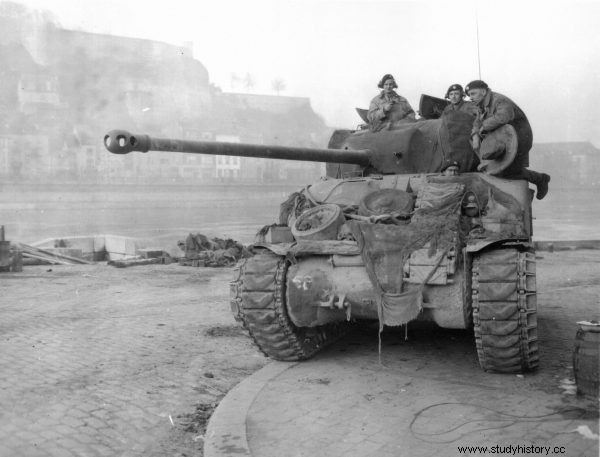
British Sherman Firefly in the Belgian city of Namur (photo:U.S. Army Center of Military History, public domain).
Skorzeny was given just five weeks to set up the branch . The new "English-speaking" Wehrmacht unit was designated the 150th Panzer Brigade. Soon, the search for suitable candidates began in military units all over Germany.
About 400 English-speaking soldiers were found. Only 10 of them were fluent with an American accent, which was the most important requirement for recruiting.
Camels and chewing gum
At the beginning of December, a unit was created out of people who spoke English best, to carry out subversive missions. It had around 50 soldiers and was named after Einheit Stielau, after the hauptsturmführer Stielau commander.
In order for the saboteurs to learn the characteristic Yankee military slang , they were sent for training to POW camps in Kostrzyn and Limburg . And since most of them were green on special operations, they were given an intensive course in the use of explosives and communications. In addition, they were acquainted with the organization, drill, and symbolism of the enemy's armed forces.
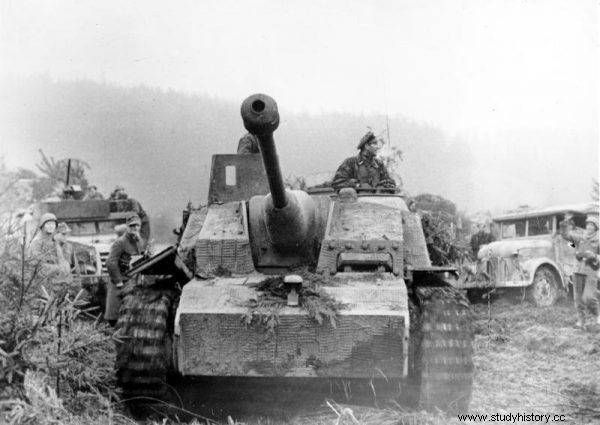
A German armored gun with the American M3 Half-track in the background (photo Pospesch, from the Bundesarchiv collection, Bild 183-J28475 / CC-BY-SA 3.0).
The task of Stielau's group was to recognize and disorganize the movements of the enemy troops by moving signposts and attacking all kinds of warehouses, communication points and headquarters. In addition to the US Army uniform sorts, German saboteurs received American weapons, mainly M1 Garand rifles and Colt M1911 pistols.

The article was based, inter alia, on on Anthony Beevor's book "Ardennes 1944. Hitler's Last Chance" (Horizon Mark 2016).
All sorts of personal details such as letters or photos taken from the killed Americans have not been forgotten and even Camel and Lucky Strike cigarettes and chewing gum. Soldiers were also given counterfeit dollars and pounds. Each of them also received a vial of poison in case of exposure. Those captured in the uniforms of the enemy army could only expect death.
Getting around is important
Einheit Stielau went into action on the night of December 15/16, 1944, 44 soldiers, divided into small teams of 4 to 6 people, in captured jeeps or on foot, thanks to various stratagems, managed to get through the lines of American troops. Antony Beevor writes in his book "Ardennes 1944":
Some groups focused on minor sabotage actions - telephone wires were cut and signposts replaced to wreak havoc in the enemy's hinterland. One even managed to misdirect an entire US infantry regiment .
Another team managed to persuade a squad of Yankees to leave their positions ahead of the allegedly powerful Wehrmacht groups approaching.
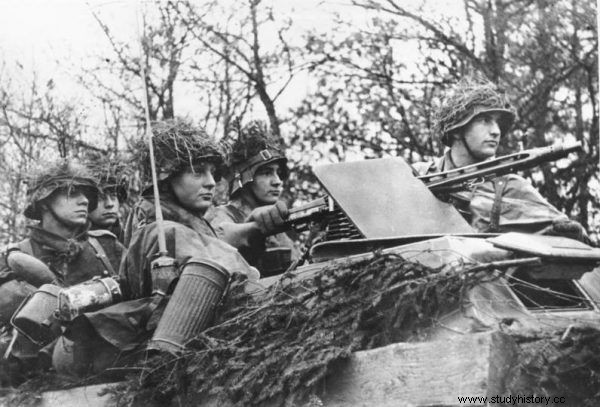
German soldiers during the offensive in the Ardennes (photo:Göttert, from Bundesarchiv collection, Bild 183-J28519 / CC-BY-SA 3.0)
Chaos was slowly creeping into the ranks of the US army. American commanders were often informed of the columns of their own troops wandering in the field. In addition, they heard news of some strange soldiers in American uniforms who often spoke German. The situation cleared up when one of the German sabotage teams fell into the hands of the Yankees.
This article has more than one page. Please select another one below to continue reading.Attention! You are not on the first page of the article. If you want to read from the beginning click here.
Purpose - Eisenhower
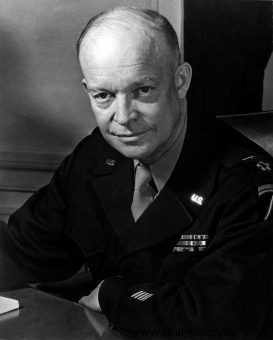
General Dwight Eisenhower hid for a week from Skorzeny's commandos, who weren't hunting him at all (Photo:Messerlin, U.S. Army, public domain).
On December 17, a Jeep with three passengers was stopped at a checkpoint near Aywaille. These people did not know the correct ID password. During the search, counterfeit money, poison and German weapons were found under the Jeep seat. The Americans quickly fixed it. that they are dealing with Germany.
During an interrogation in a nearby unit, one of the detainees, Obergefreiter Wilhelm Schmidt, revealed to the astonished investigators that the main task of the unit created and led by Otto Skorzeny was General Dwight Eisenhower himself . The Germans allegedly intended to attack the headquarters of the Allied Expeditionary Forces (SHAEF) in Paris and kill the popular Ike.
Due to Skorzeny's reputation, the Americans reacted quite nervously to the revelations. Eisenhower moved around the city only in a heavy armored car, and from December 19 he was practically interned for a week in the SHAEF headquarters . The entire building was then surrounded by barbed wire entanglements, security was significantly increased, passes were meticulously checked, and even several tanks were brought nearby.
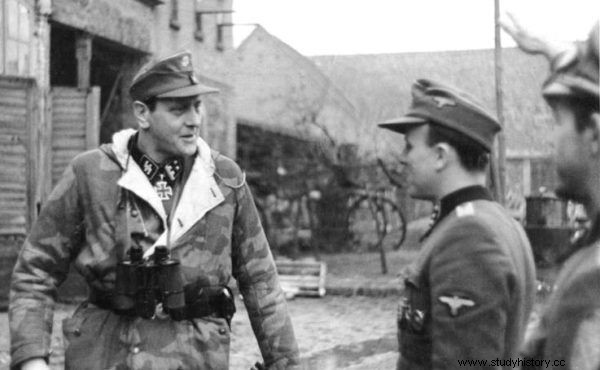
Otto Skorzeny in February 1945 (photo:Bundesarchiv, Bild 183-R81453 / CC-BY-SA 3.0).
Pissing Monty off… priceless
Similar things happened in the field, there was a real psychosis of fear of subversives . In order to catch them, the American gendarmerie questioned in detail during the inspection about various nuances of everyday life in the United States. Even higher commanders did not avoid it. As General Bradley recalled:
The first time they wanted me to consider Springfield as the capital of Illinois (...), the second time they asked if the position of a defender in football was between the center forward and the link; the third time I had to say who is the next spouse of the beautiful blonde Betty Grable at the moment ...
The American boys even took their toll on the proud and arrogant Marshal Montgomery, who made an official statement on this complaint to the staff of the 9th Army.
An interesting and somewhat humorous situation is described by Antony Beevor in the aforementioned "Ardennes" in reference to the famous British actor David Niven. He was then serving as a reconnaissance officer in the "Phantom" communications regiment, but paraded in the uniform of the Rifle Brigade. It was this outfit that aroused the suspicions of the American patrol:
The question was:
- Who won the 1940 baseball championship?
- I have no idea but I know I played in Ginger Rogers movie.
- Okay, get off Dave, - the reassured gendarme replied, - but put on some decent rags, damn it.
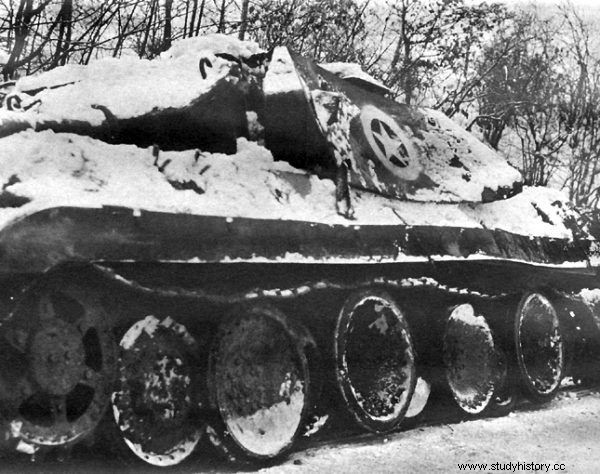
Destroyed Pantera tank, which was supposed to pretend to be the American M10 Wolverine tank destroyer (photo:United States Department of Defense).
The commander of the defense of the town of St. Vith, General Bruce Clarke. He was detained for five hours by… his own soldiers! When he tried to persuade him, one of his guards replied: Don't make me laugh. You are one of those Nazi killers .
End of Einheit Stielau

The article was based, inter alia, on on Anthony Beevor's book "Ardennes 1944. Hitler's Last Chance" (Horizon Mark 2016).
However, the actions taken by the Americans began to bear fruit gradually. One of the teams was liquidated on the spot when the gendarmes discovered irregular footwear in the detained soldiers. The other one exposed himself because of the wrong caps.
The last saboteur from the Einheit Stielau group was shot dead on December 26 near the town of Hotten. In the meantime, another dozen of his companions were caught. In total, 22 of them were captured, of which 20 were sentenced to death by shooting or hanging. Overall, 8 out of 44 people who left for American lines survived the war.
Despite causing panic among the enemy ranks and causing several American generals to have heart palpitations, the German saboteurs failed. First of all, they failed to capture the bridges over the Meuse, which were the main target of the operation.
The reasons for this were too small forces that were directed to the action, as well as hasty and not very thorough training and equipment of the Germans themselves. When faced with the Yankee gendarmes, ignorance of the realities of the American way of life was essential. However, this does not change the fact that thousands of Allied soldiers were involved in the search for saboteurs, who would definitely be more useful at the front.
